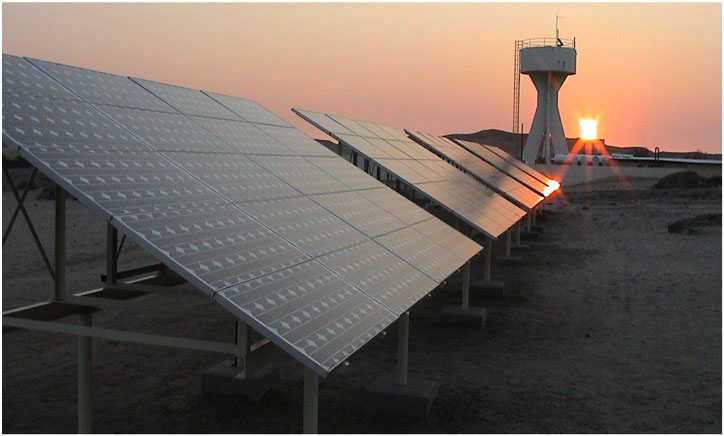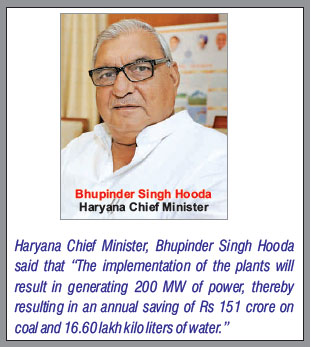In view of modernizations and increasing power demands state Govt. of Haryana have taken a major step 1st time in India, “mandating solar installation in all plots of the state, to meet at least 5% of their connected load subject to a minimum of 1 kW”. Mandatory installation of solar power plants has been applicable to all categories like nursing homes, hospitals, group housing societies and others. So will it going to meet expected results or will be another vain project.
 Haryana has been experiencing a substantial growth in its electricity demand and the state discoms have been finding it difficult to satisfy the demand. The state has been very little by way of solar installations in a country where solar energy has become the main thrust of the national solar energy policy. Every state is competing with others to attract solar investments and increase the use of solar energy for electricity. Once implemented, the installations can add up to about 200 MW worth of solar capacity. The state government is planning to provide subsidy of up to 30% of the system’s capital cost, on a first-come-first-served basis. The Haryana Solar Policy makes a mention that funds for providing financial assistance shall be generated by levying a solar cess (or tax) on the consumer electricity bill at a rate of 0.02/kWh (0.03¢/kWh). The state government seems quite motivated to meet its target as failure to install the solar panels by September would attract penalties between 10,000 and 1 million.
Haryana has been experiencing a substantial growth in its electricity demand and the state discoms have been finding it difficult to satisfy the demand. The state has been very little by way of solar installations in a country where solar energy has become the main thrust of the national solar energy policy. Every state is competing with others to attract solar investments and increase the use of solar energy for electricity. Once implemented, the installations can add up to about 200 MW worth of solar capacity. The state government is planning to provide subsidy of up to 30% of the system’s capital cost, on a first-come-first-served basis. The Haryana Solar Policy makes a mention that funds for providing financial assistance shall be generated by levying a solar cess (or tax) on the consumer electricity bill at a rate of 0.02/kWh (0.03¢/kWh). The state government seems quite motivated to meet its target as failure to install the solar panels by September would attract penalties between 10,000 and 1 million.
 What the Policy is?
What the Policy is?
The Haryana government has made it mandatory for all buildings on plot size of 500 square yards or more to install rooftop solar power systems by September 2015. The order will be applicable to private bungalows, group housing societies, builder apartments, malls, offices, commercial complexes, schools, hospitals — any building, new or old, that meets the plot size criteria. The official release mentioned that in case of all the residential buildings, which are constructed on a plot size of 500 square yards and above falling within the limits of MCs and HUDA / HSIIDC sectors, the mandatory installation of solar power plant to be installed will be of minimum 1 kW or five per cent of connected load, whichever is more. The government will offer a 30% subsidy on installation costs on “a first-come-first-served” basis, which means it would depend on availability of funds. The order, passed by the department of renewable energy, is in line with the state’s solar power policy framed in September 2014, officials said. Its implementation will help the power-hungry state augment generation and ease pressure on its distribution network that’s prone to breakdowns, particularly in Gurgoan where demand is very high. The minimum solar power capacity to be installed is 1 kilo Watt or 5% of a building’s connected load, whichever is higher. A 1 kW plant can generate up to 4.5 units of electricity a day, enough to power three fans, seven tube-lights and a cooler for four to five hours, said Sandeep Yadav, project officer of the state’s department of renewable energy. Failure to install the solar panels by September would attract penalties between Rs 10,000 and Rs 10 lakh, officials said. Additional deputy commissioners (ADC) of all districts in Haryana will be the implementation officers for the government’s mandatory solar power program. The execution of the mandatory provisions will result in saving 320 million units annually and at the same time three lakh MTs of annual carbon emission will also be prevented from polluting the atmosphere. Consumers who generate excess electricity will be able to supply the same to the grid and claim a credit on their power bills.
Will Haryana witness a “PV Revolution”
From outside it seems to be radical action taken by the Govt. But when we dig inside the market trends, Haryana economical & social environment and other facts we came out with many point putting question mark on success of the mission. Some considerations to be noted are:
- Clearing subsidies punctually will be an important factor in the success of the program. This has been a problem earlier with the Ministry of New and Renewable Energy. Several PV installers have earlier asked for the subsidy regime to be ended, as they have considered it to be more of a hindrance. Sometime back, MNRE also pulled the plug on subsidy for solar water heaters.
- PV installations in public & domestic building in lack of proper knowledge or awareness or in Govt. pressure could result in a mess-up. Short deadline push may encourage fly-by-night operators in the local installations. State Govt. should have set-up some qualifying parameters for both product & companies or could have prepared a list of authorized solar vendors/installers.
- 15% – 30% subsidy!!! What will be the source of this fund? Aren’t this is going to be another added paper-work and admin burden on either the end user or the installer. Also the “first-cum-first serve” basis may only add to unethical practices. If the end-customer has to take the responsibility of the subsidy; then it will create a new market for agents/in-between players who will assist these solar owners to get subsidy from the government. The State can also look at direct tax incentives for solar installations.
- Net-metering clause will also bring in other challenges. Rate at which discoms buy additional power needs to be analyzed. Also to solve technical challenges, the State could have initiated net-metering demo projects on government buildings.
- The State is looking at a target of 50MW. But pushing such targets or clauses on the end -customer makes general public uncomfortable. Yes, the policy can make it mandatory for new buildings or government buildings, but then pushing private companies/families into this suddenly can create an uncomfortable environment.
- What steps are to be taken if there is not enough space to put the solar plant in the building? What happens when the solar plant is not feasible for that particular building? For now, an education drive will be useful to help people understand the process of buying/installing a solar power plant.
- Housing complex of Gurgoan, Panchkula like cities in Haryana may have 50 – 100 flats in a single rooftop building. Power consumption is drastic in comparison to the available open area for the PV installation. Now the question arises, how such complex will set-up solar panels, How generated power will be distributed in 50 – 100 flats in a single building or Whose responsibility is to get the systems installed the owners or the rentals.
Conclusions
Policy seems to be ground-breaking but it should be followed by a round of awareness generation campaign. As of now if quality & authenticity concerns will be taken care immediately there are chances for the policy to be come out as an example of un-planned drive rather than a nation-wide revolution. State Govt is required to sit with PV companies & organizations to get these installations done in right manner and long-run structure but not just a model to show-up.







